With Cocoa being one of the most popular ingredients in the world, the demand for Cocoa continues to rise, making it an excellent opportunity for those wanting to make a living out of it. Cocoa is a tropical tree native to the Amazonian region of South America. It is a significant source of cocoa beans used to make chocolate, cocoa powder, and other chocolate-based products. Cocoa is grown in various countries, including Ghana, Indonesia, Brazil, and the Ivory Coast, which account for around 75% of global cocoa production.
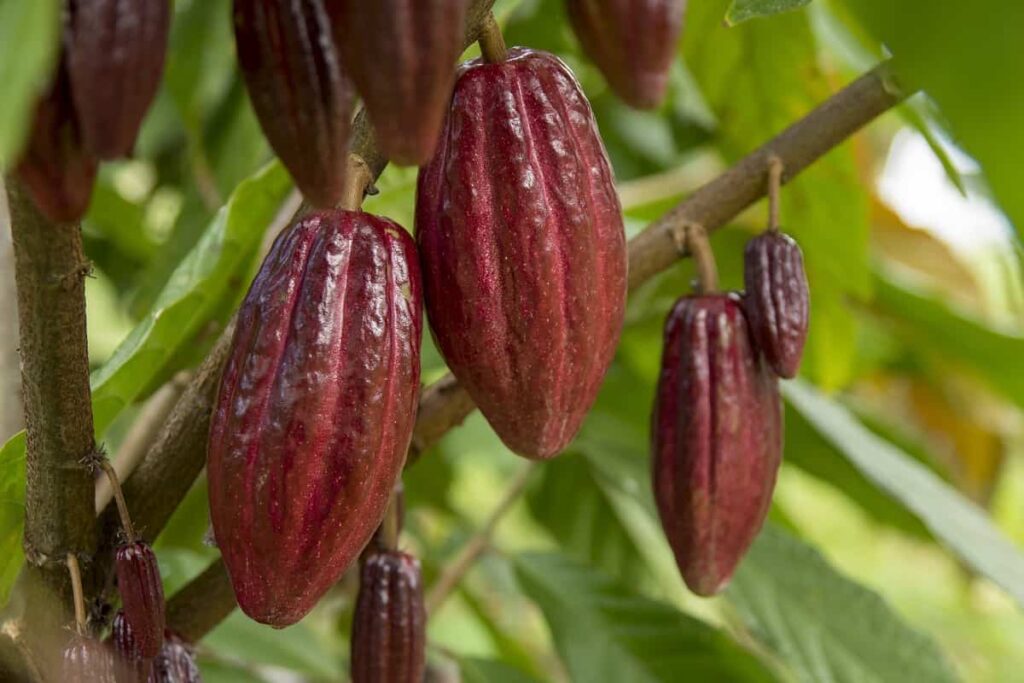
Cocoa flowers are small and white and are produced year-round on the trees. Small insects called midges pollinate these flowers, and the resulting fruit, known as a cocoa pod, contains around 20-40 cocoa beans. The pods are harvested by hand, and the beans are extracted and processed to make cocoa products. With careful cultivation and proper management, Cocoa can continue to be a sustainable and profitable crop for years.
Cocoa trees take around three to five years to start producing cocoa pods containing the seeds used to make cocoa products. The pods are harvested by hand, and the seeds are extracted, fermented, and dried before they are shipped to processing facilities. This guide will provide an in-depth look into cocoa farming, from getting started to the challenges you may face. It will provide you with the necessary information to make informed decisions and help you establish a successful cocoa farm.
How to start Cocoa farming from scratch
Uses of Cocoa
There are many uses for Cocoa in various industries and applications. Some common uses for Cocoa include:
- Food and Beverage Industry: Cocoa is a key ingredient in many chocolate products, including chocolate bars, chocolate chips, and chocolate drinks. It is also used in baked goods such as cakes, cookies, and brownies.
- Cosmetic Industry: Cocoa is rich in antioxidants and has anti-inflammatory properties, making it a popular ingredient in skincare products such as face masks and moisturizers.
- Medicine: Cocoa has been shown to have potential health benefits, including reducing blood pressure and improving cardiovascular health. As such, it is being studied as a potential treatment for certain medical conditions.
- Animal Feed: Cocoa meal, a byproduct of cocoa processing, is often used as a feed ingredient for livestock and poultry.
- Industrial Uses: Cocoa butter is used in producing candles, soaps, and other personal care products. It is also used as a lubricant in certain industrial applications.
Cocoa production countries in Asia
| Indonesia | Thailand |
| Vietnam | China |
| India | Papua New Guinea |
| The Philippines | Sri Lanka |
| Malaysia | Bangladesh |
In case you missed it: Key Rules for Kitchen Gardening: How to Start from Scratch, Plan, the Principles, Ideas, and Tips
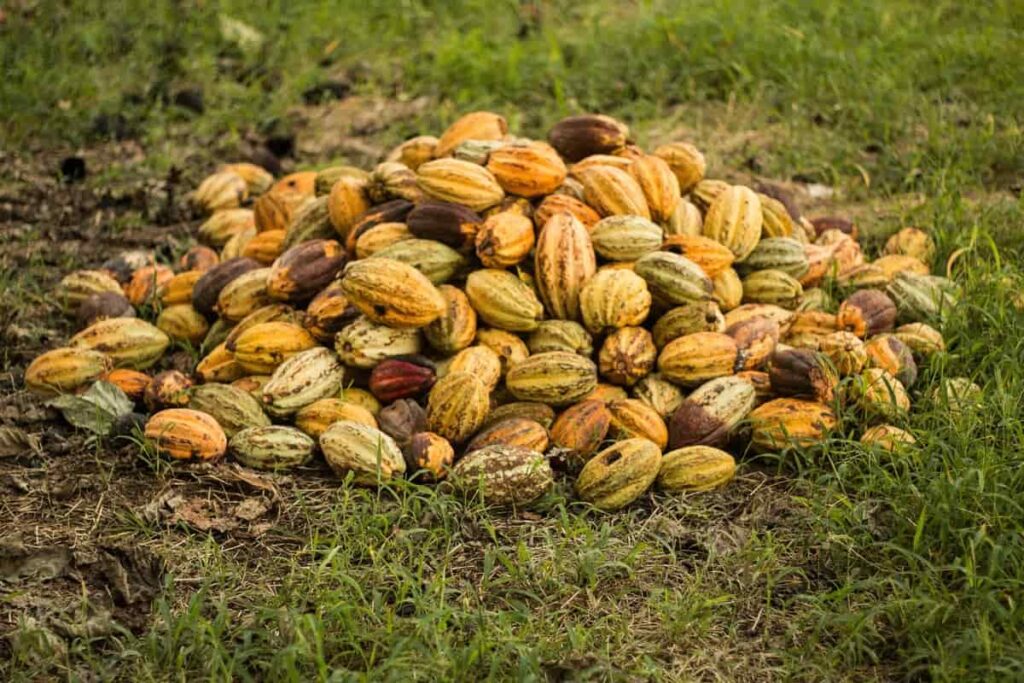
Local names of Cocoa in Asia
| Kakao | Indonesia |
| Coklat | Malaysia |
| Sắc dừa | Vietnam |
| Côcoa | Thailand |
| Cacao | Philippines |
| කොකොලා | Sinhala, Sri Lanka |
| சப்பாத்தி | Tamil, India |
| 코코아 | Korea |
| 牛奶可可 | China |
| ココア | Japan |
Top Cocoa production countries in the world
| Ivory Coast | Ecuador |
| Ghana | Cameroon |
| Indonesia | Vietnam |
| Nigeria | Dominican Republic |
| Brazil | Peru |
Top Cocoa production states in India
- Kerala: Kerala is India’s top cocoa-producing state, with an annual production of around 36,000 metric tons. The state is home to several cocoa plantations, and its favorable climatic conditions are ideal for cultivation.
- Tamil Nadu: Tamil Nadu is India’s second-largest cocoa-producing state, with an annual production of around 20,000 metric tons. The state has several cocoa estates, and its warm and humid climate is well-suited for cocoa cultivation.
- Karnataka: Karnataka is India’s third-largest cocoa-producing state, with an annual production of around 15,000 metric tons. The state has several cocoa plantations, and its tropical climate is conducive to cultivation.
- Andhra Pradesh: Andhra Pradesh is India’s fourth-largest cocoa-producing state, with an annual production of around 12,000 metric tons. The state has several cocoa estates, and its warm and humid climate is ideal for cultivation.
- Maharashtra: Maharashtra is India’s fifth-largest cocoa-producing state, with an annual production of around 10,000 metric tons. The state has several cocoa plantations, and its tropical climate is well-suited for cocoa cultivation.
Step-by-step guide for beginners in Cocoa farming
About Cocoa plant
Cocoa is grown from cocoa beans, which make chocolate, cocoa powder, and other chocolate-based products. The cocoa plant can grow up to 30 feet tall and has dark green leaves, small white flowers, and oval-shaped pods that contain cocoa beans. The beans are harvested by hand and then processed to extract the cocoa butter and cocoa solids, which are the main ingredients in chocolate. The cocoa plant requires warm, humid conditions and well-draining soil to thrive. It is also sensitive to frost and drought, so it is typically grown in areas with consistent rainfall and high humidity.
In case you missed it: Key Rules to Start a Butterfly Garden from Scratch: Butterfly Gardening Layout, Design for Home, and Backyard
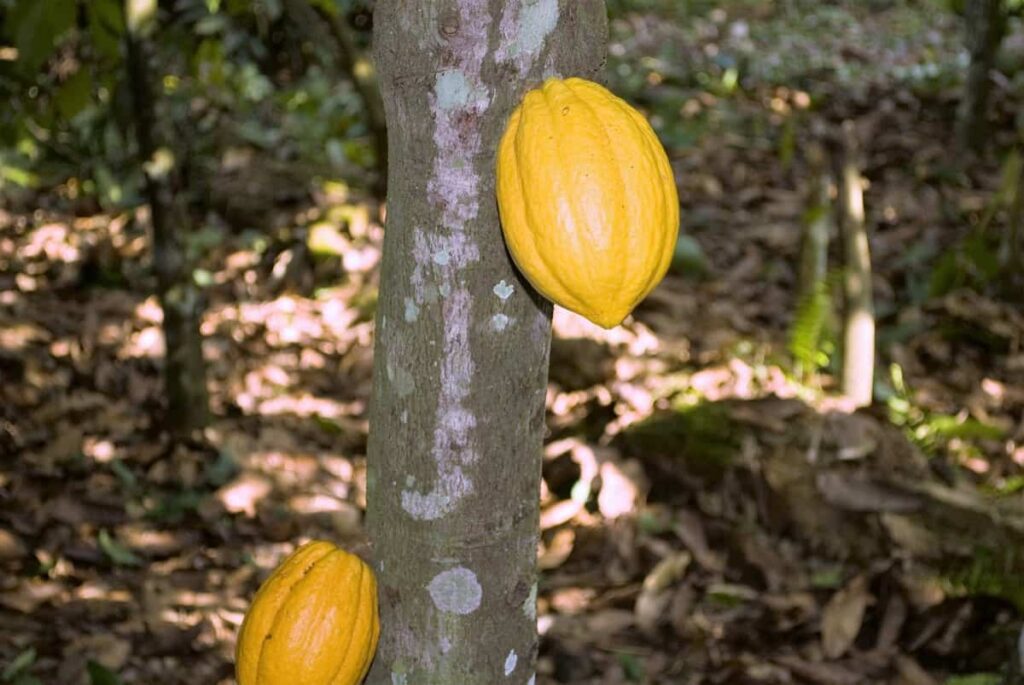
Varieties/hybrids of Cocoa:
- Forastero: This is the most commonly cultivated cocoa variety known for its hardiness and high yield. It is often used in bulk chocolate production.
- Criollo: This variety is known for its delicate aroma and flavor and is often used in high-quality chocolate production. It is more delicate and less hardy than Forastero.
- Trinitario: This is a hybrid of Forastero and Criollo and is a cross between the two varieties in terms of flavor, aroma, and hardiness. It is also used in high-quality chocolate production.
- Nacional: This variety is native to Ecuador and is known for its high quality and unique flavor. It is a rare variety and is often used in fine chocolate production.
- Amelonado: This hybrid of Forastero and Trinitario is known for its high yield and disease resistance. It is often used in bulk chocolate production.
- Porcelana: This pure, high-quality cocoa variety is known for its light-colored beans and delicate flavor. It is often used in high-end chocolate production.
Selection of site for Cocoa farming
Temperature, climate, and rainfall requirements for Cocoa farming: Cocoa farming requires a humid tropical climate with consistent temperatures between 20-32°C. Cocoa trees need to receive plenty of rainfall, ideally between 1,500-2,500mm per year. However, cocoa trees can tolerate short dry periods and survive irrigation.
Cocoa trees also require high humidity levels, preferably over 75%. Cocoa farming is typically found in countries located within 20° north and south of the equator, such as West Africa, South America, and Southeast Asia Cocoa trees thrive in tropical climates with high humidity and rainfall. However, they also need at least 2-3 dry months per year to allow the trees to rest and produce fruit.
Soil type: Cocoa trees prefer well-draining, slightly acidic soil with a pH of 5.5-6.5. The soil should also have a good supply of organic matter and nutrients.
Access to water: Cocoa trees require a consistent water supply, especially during the dry season. It is essential to choose a site with access to irrigation or a reliable source of water.
Market access: Choosing a site close to a market selling cocoa beans is essential. It will help ensure that the farmer can get a reasonable price for their product and minimize transportation costs.
Soil requirement for Cocoa farming
Cocoa plants require well-draining soil that is rich in organic matter and nutrients. The ideal soil pH for cocoa farming is between 5.5 and 6.5. The soil should also have good water retention capabilities, as cocoa plants require a consistent moisture supply to thrive. In addition, cocoa plants prefer a sunny location with plenty of direct sunlight. They also do well in high humidity and warm tropical climates.
In case you missed it: How to Build Raised Bed Garden from Scratch: Plan, and Design for Beginners
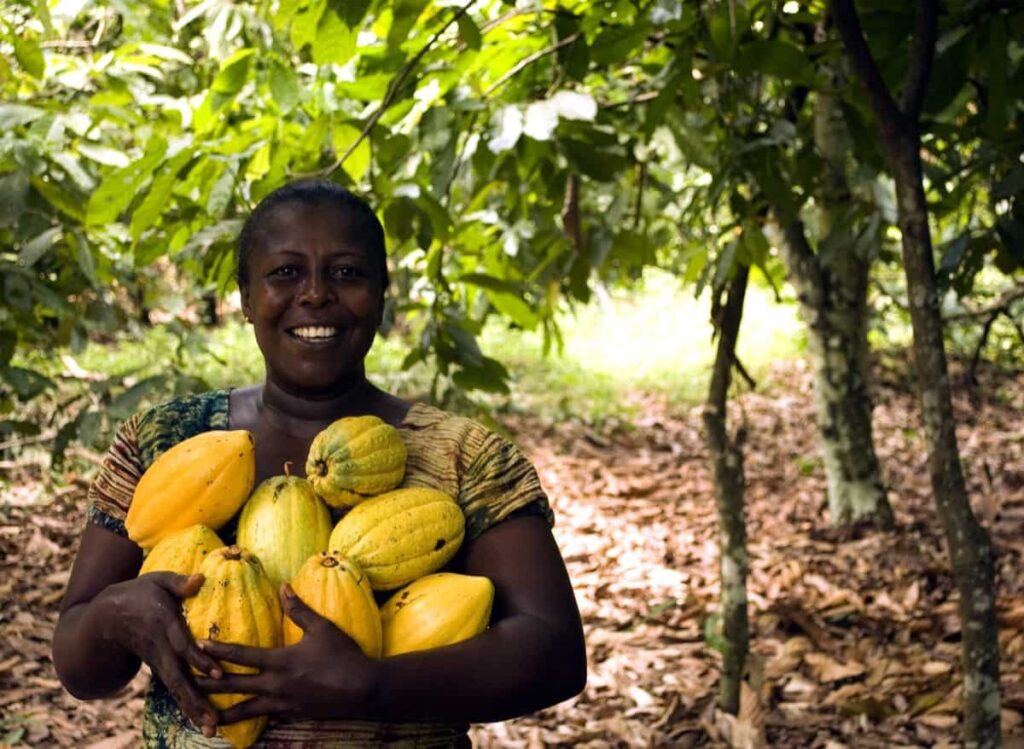
Land preparation for Cocoa farming
- Clear the land: The first step in preparing land for cocoa farming is to clear any weeds, grass, or debris that may be present. This can be done manually or in primary tillage Operations or with herbicides.
- Remove stumps and roots: Any stumps or roots on the land should be removed to create a clear and level surface for planting. It can be done by using a stump grinder or manually digging them out.
- Plow the soil: The next step is to plow the soil to loosen it and prepare it for planting. It can be done with a tractor or manually with a plow.
- Apply fertilizers: Once the soil is plowed and cleared, it is crucial to enrich the soil and provide the necessary nutrients for the cocoa trees to grow. It can be done with organic or chemical fertilizers.
Propagation of Cocoa farming
The cocoa plant is propagated by planting cocoa seeds or cuttings taken from mature trees. To propagate cocoa seeds, the seeds are first removed from the cocoa pods and dried in the sun for a few days. They are then planted in well-draining soil and covered with a thin layer of soil. The seeds should be watered regularly until they germinate and sprout. Once the seedlings are strong enough, they can be transplanted to a permanent location in the field.
A cocoa nursery must have enough shade, irrigation, and wind protection. The nursery should have at least 50% shade. The land should be level and devoid of rodents and pathogens. A micro sprinkler provides irrigation. To propagate cocoa trees through cuttings, cuttings are taken from mature trees and planted in pots or directly in the field. The cuttings should be watered regularly until they are well-established and ready to be transplanted to a permanent location in the field.
Spacing and planting in Cocoa farming
Cocoa farming involves planting cocoa trees in a specific spacing pattern to allow for optimal growth and production. Cocoa seedlings are planted in 50 cm3 compost-filled pits. The spacing between cocoa trees can vary depending on the farmer’s specific farming techniques and goals. Still, generally, it is recommended to plant cocoa trees at a spacing of 4-6 meters apart.
This spacing allows enough space for the trees to grow and reach their full potential while also allowing for efficient management and maintenance of the cocoa farm. Additionally, this spacing can help to reduce the risk of pests and diseases spreading between trees, as it reduces the likelihood of the trees being near each other.
- Forest spacings of 2.5 x 2.5 m to 3.0 x 3.0 m are suitable.
- Cocoa is planted at 2.7 x 5.4 m spacing in the areca garden, while the main crop is planted at 2.7 x 2.7 m.
- When grown as an intercrop with coconut, two systems are usually followed by a single hedge 2.7 m apart or a double hedge 2.5 m apart.
Intercropping in Cocoa farming
Some common crops intercropped with Cocoa include plantains, cassava, pineapple, and legumes such as beans and peanuts. These crops can provide shade for the cocoa trees, improve soil quality, and provide additional food sources for the farmer and their family. The canopy height should be limited to two storeys when grown as an intercrop of palms. According to studies on spacing and pruning, a spacing of 2.7 x 5.4 m and a canopy area of 15-20 m2 yielded the highest bean yield.
Pruning in Cocoa farming
To maintain a healthy canopy, the cocoa tree should be pruned regularly. Formation pruning is required in young cocoa plants. It is primarily done to adjust the height of the first jorquette. The jorquette can grow to 1-2 metres, aiding cultural operations. Pruning in mature Cocoa is classified into two types: sanitary pruning and structural pruning. Diseased or unnecessary branches are removed during sanitary pruning. The canopy is pruned structurally to achieve the desired size and architecture. To avoid self-shading of leaves, pruning practices should maintain maximum leaf area.
In case you missed it: A Guide to Regenerative Agriculture: What is Regenerative Agriculture?, How to Start from Scratch
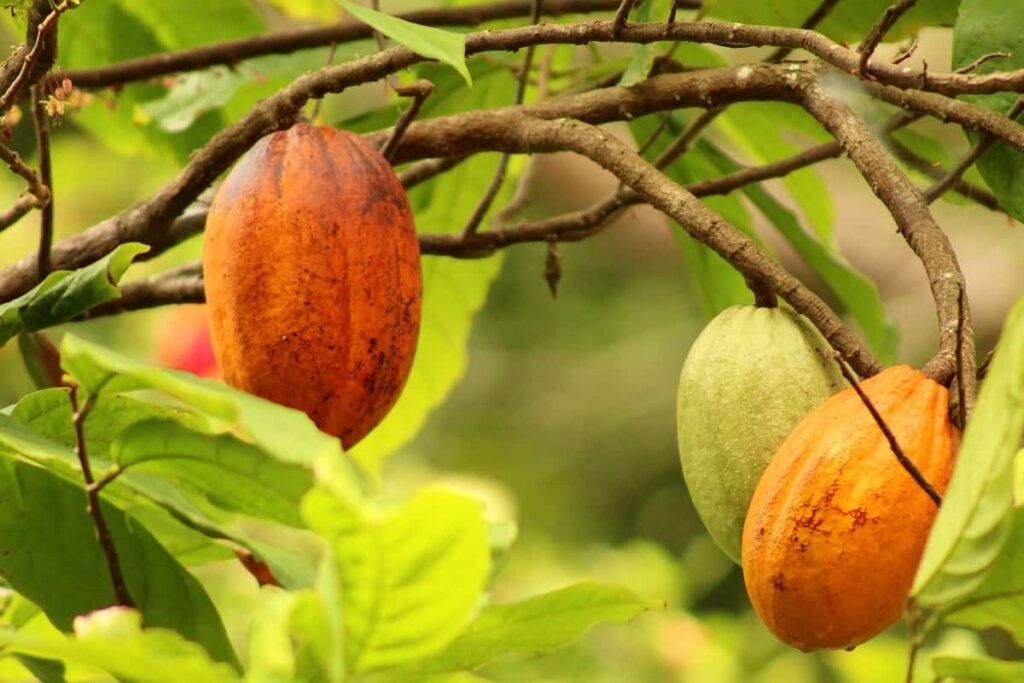
Manures and fertilizers in Cocoa farming
In cocoa farming, manures and fertilizers are necessary for maintaining soil fertility and providing essential nutrients to cocoa trees. Manures are organic materials derived from animal or plant sources and used to enrich the soil. They can be applied directly to the soil or used as mulch around the base of the cocoa trees.
Several fertilizers can be used in cocoa farming, including nitrogen, phosphorous, and potassium (NPK) fertilizers, the primary macronutrients that cocoa trees need. Cocoa needs 100 g N (220 g urea), 40 g P2O5 (200 g rock phosphate), and 140 g K2O (235 g potash muriate) per plant per year.
- Nitrogen fertilizers: Nitrogen is an essential nutrient for cocoa plants, as it promotes leaf growth and helps form chlorophyll. Nitrogen fertilizers can be applied as a liquid or a granule and can be derived from natural sources such as compost or synthetic sources such as urea.
- Phosphorous fertilizers: Phosphorous is essential for root development, flower and fruit production, and overall plant growth. Phosphorous fertilizers can be applied as a liquid or a granule and can be derived from natural sources such as bone meal or synthetic sources such as triple superphosphate.
- Potassium fertilizers: Potassium is essential for the proper development and growth of cocoa plants, as it helps to regulate water uptake and the synthesis of proteins and carbohydrates. Potassium fertilizers can be applied as a liquid or a granule and can be derived from natural sources such as wood ash or synthetic sources such as potassium chloride.
Other essential micronutrients that cocoa trees require include zinc, manganese, iron, and boron.
Irrigation in Cocoa farming
Irrigation in cocoa farming artificially supplies water to cocoa trees to support their growth and production. It is essential in areas where there is limited or inconsistent rainfall. Drip irrigation is the most common method, as it delivers water directly to the roots of the cocoa trees through a system of tubes and emitters. Sprinkler irrigation involves using sprinklers to spray water over the entire area.
Cocoa responds well to drip irrigation. Maximum yields are obtained when Cocoa is drip-irrigated at a rate of 20 litres per day per tree. Without sufficient water, the trees may become stunted or even die. Additionally, irrigation helps to control the spread of pests and diseases, as moist conditions are often necessary for their growth.
Pests & disease management in Cocoa farming
Cocoa farming can be affected by various pests and diseases that can significantly impact crop yields and quality. Therefore, effective pest and disease management is essential for the success of cocoa farming operations.
Common pests that can affect cocoa crops include
- Capsids are small, green insects that feed on the leaves and shoots of cocoa trees. They can cause significant damage to the plant and reduce crop yields.
- Mealybugs: These insects feed on the sap of cocoa trees and can cause damage to the leaves, stems, and fruit. They can also produce a sticky, sugary substance that can attract ants and other pests.
- Scale insects: These pests can damage the bark and branches of cocoa trees, reducing the tree’s ability to produce fruit.
- Spider mites: These small, spider-like insects can cause damage to the leaves of cocoa trees, reducing the tree’s ability to photosynthesize and produce fruit.
Common diseases that can affect cocoa crops include
- Black pod disease: This fungal disease affects the fruit of cocoa trees, causing the pods to turn black and rot. It can significantly reduce crop yields.
- Root rot: This fungal disease can attack the roots of cocoa trees, reducing the tree’s ability to absorb nutrients and water. It can lead to the death of the tree if not treated.
- Witches’ broom: This fungal disease causes the cocoa tree to produce abnormal, broom-like growths on the branches and leaves. It can reduce crop yields and the quality of the cocoa beans produced.
In case you missed it: Top 15 Effective Organic Home Remedies for Garden Pests: Proven Control Methods
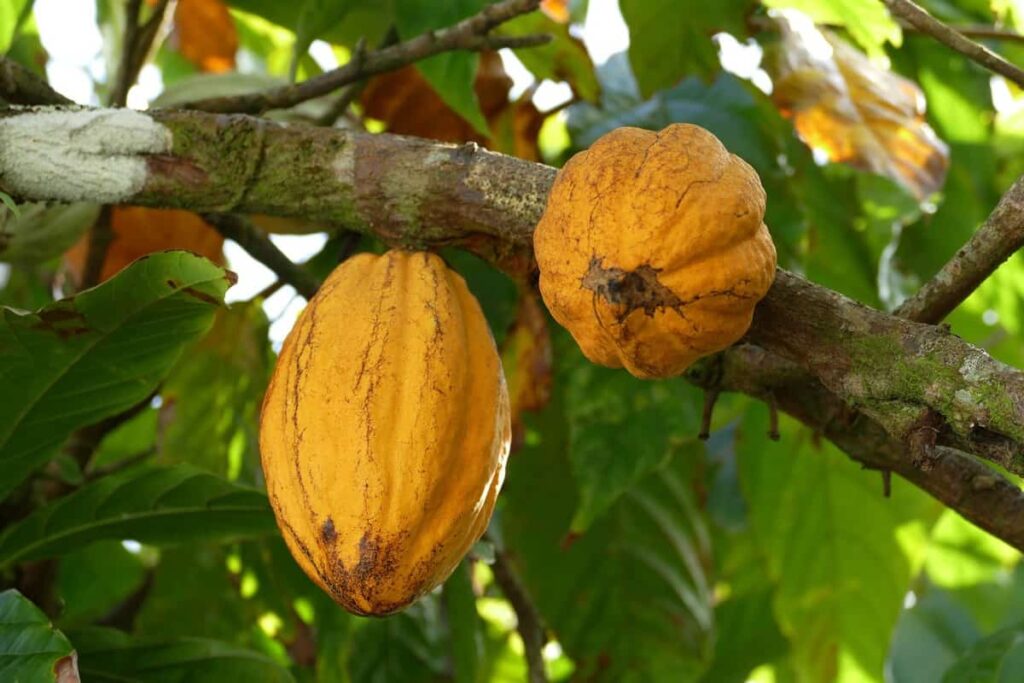
Strategies to manage pests and diseases in cocoa farming
- Cultural controls include crop rotation, pruning, and proper irrigation to reduce the risk of pests and diseases.
- Chemical controls: Pesticides and fungicides can be used to control pests and diseases, but care must be taken to ensure that they are used in an environmentally responsible manner.
- Biological controls: Using natural predators or parasites to control pests and diseases can be a more sustainable option.
Harvesting & post-harvesting in Cocoa farming
- Identifying when the cocoa pods are ready for harvest: Cocoa pods are ready for harvest when they turn yellow or orange and are slightly soft to the touch. It usually occurs after about 5-6 months of growth.
- Cutting the pods from the tree: Cocoa pods are typically cut using a small knife or machete. Care is taken to avoid damaging the tree or the surrounding pods.
- Breaking open the pods: Once they are cut from the tree, they are broken open to reveal the cocoa beans inside. It is typically done using a hammer or mallet.
- Removing the cocoa beans: The cocoa beans are carefully removed from the pod and placed in a basket or container.
- Drying and curing the beans: The cocoa beans are then dried in the sun or in a drying facility to reduce their moisture content. After drying, they are placed in a curing process, which involves heating and turning the beans to ensure they are evenly cured.
- Grading and sorting the beans: After curing, the beans are graded and sorted according to size, shape, and quality.
- Packaging and shipping the beans: The final step in the harvesting process is packaging and shipping the beans to buyers or processing facilities for further processing into cocoa products such as chocolate.
Cocoa is the dried, and fermented seed of the cacoa tree used to make chocolate. “Cocoa” can also refer to the drink known as hot chocolate; cocoa powder, the dry powder made by grinding cocoa seeds and separating the cocoa butter from the dark, bitter cocoa solids; or the combination of cocoa powder and cocoa butter.
Yield in Cocoa farming
The yield of cocoa farming varies depending on various factors such as location, weather conditions, soil quality, and farming practices. A cocoa tree can produce around 25-30 kilograms of cocoa beans yearly. However, yields can range from as low as 10 kilograms to as high as 50 kilograms per tree per year. Factors such as tree age, irrigation, pruning, and pest and disease control can also affect the yield of cocoa farming.
- Crops Grown in Summer Season: Best Choices for Summer Gardening
- Organic Pest Control for Tomato Farming
- How to Maximize Sheep Farming Profit
- Broccoli Varieties: Choosing the Right Cultivars for Your Farm
- How to Raise Pigs in Your Own Backyard: A Comprehensive Guide
- Budget Friendly Sheep Shed Ideas: Cheap and Low-Cost Tips
- How Much Do Cattle Farmers Make: Revenue Streams in Cattle Farming
- Management Pests and Diseases in Your Cotton Field
- Sheep Farming Business Plan for Beginners
- Aquaponic Farming at Home: A Step-By-Step Guide
- Profitable Village Farming Business Ideas in 2024
- High-Yield Aquaculture: Fast-Growing Fish for Farming
- Effective Fish Pond Construction Techniques for Beginners
- Irrigation and Water Management in Pineapple Farming
- Blossom to Harvest: Mastering Flowering and Pollination in Papaya Farming
- Pig Fattening Essentials: From Selection to Sale for Beginners
- Raising Wagyu Cattle: A Complete Guide for Premium Beef Production
- Soil Types and Their Water Holding Capacity
- Optimizing Irrigation Schedules for Coconut Groves for Enhanced Yield
- Espresso Your Garden: Coffee Grounds for Healthier Acid-Loving Plants
- The Best Soil Mix for Snake Plants: How to Mix Your Own Snake Plant Soil
- Green Thumb Success: Expert Tips for Cultivating Greenhouse Beans All Year Round
- Bloom All Year Round: The Ultimate Guide to Indoor Hyacinth Care
- Eco-Friendly Gardening: How to Make Liquid Fertilizer from Kitchen Waste
- Ultimate Guide to Grow Anise in Pots: Explore Seed Propagation to Harvesting
- Guide to Raising Chester White Pigs: Discover Breed Facts to Growth Management
- Mastering the Elegance: The Ultimate Guide to Weeping Cherry Tree Care, Planting, and Maintenance
- Ultimate Guide to Planting Garlic in Grow Bags: Growing Strategies for Beginners
- How to Fix Spider Plant Leaf-Related Problems: Natural and Organic Remedies
- 10 Reasons Why Your Tulsi Plant is Shedding Leaves: Home Remedies and Solutions
- Optimizing Growth and Yield: The Advantages of Palm Bunch Ash Fertilizer
- Utilizing Neem Oil Extract as a Natural Pesticide for Hydrangea
- From Soil to Harvest: Various Ways in Which Farmers Can Use AI Tools
- Steps to Encourage and Induce Citrus Flowers: A Comprehensive Guide
- How to Fix Snake Plant Leaf-Related Issues: Natural and Organic Remedies
- Transform Your Garden into a Fragrant Oasis with Raat Ki Rani (Night Blooming Jasmine)

Thanks for this information i’m a cocoa farmer and i’ve learnd alot from this
Iam a first time cocoa farmer in Nigeria and I find this very useful and helpful. Thank you for the write up.